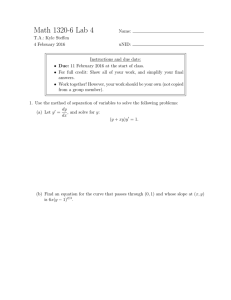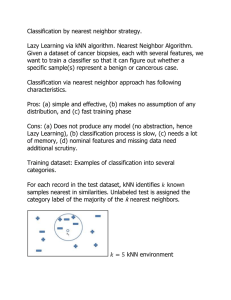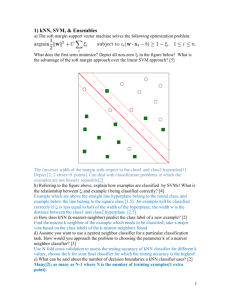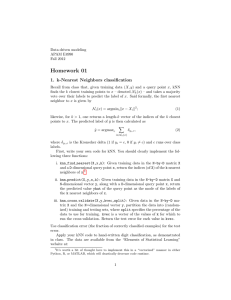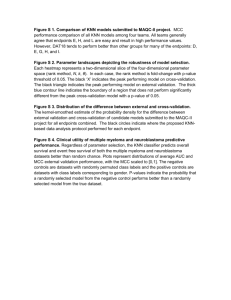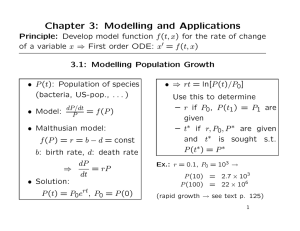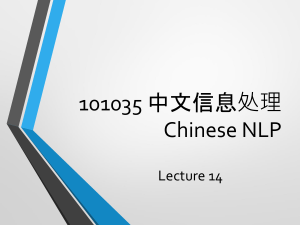IRJET-A Review on Object Tracking based on KNN Classifier
advertisement
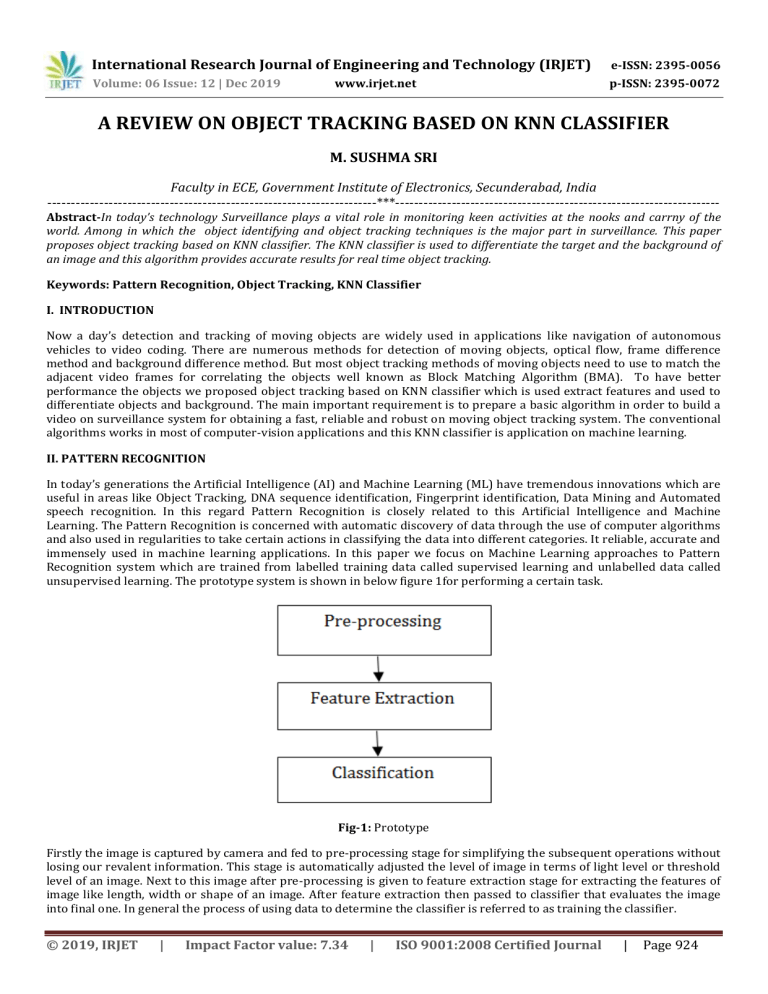
International Research Journal of Engineering and Technology (IRJET) e-ISSN: 2395-0056 Volume: 06 Issue: 12 | Dec 2019 p-ISSN: 2395-0072 www.irjet.net A REVIEW ON OBJECT TRACKING BASED ON KNN CLASSIFIER M. SUSHMA SRI Faculty in ECE, Government Institute of Electronics, Secunderabad, India ----------------------------------------------------------------------***--------------------------------------------------------------------Abstract-In today’s technology Surveillance plays a vital role in monitoring keen activities at the nooks and carrny of the world. Among in which the object identifying and object tracking techniques is the major part in surveillance. This paper proposes object tracking based on KNN classifier. The KNN classifier is used to differentiate the target and the background of an image and this algorithm provides accurate results for real time object tracking. Keywords: Pattern Recognition, Object Tracking, KNN Classifier I. INTRODUCTION Now a day’s detection and tracking of moving objects are widely used in applications like navigation of autonomous vehicles to video coding. There are numerous methods for detection of moving objects, optical flow, frame difference method and background difference method. But most object tracking methods of moving objects need to use to match the adjacent video frames for correlating the objects well known as Block Matching Algorithm (BMA). To have better performance the objects we proposed object tracking based on KNN classifier which is used extract features and used to differentiate objects and background. The main important requirement is to prepare a basic algorithm in order to build a video on surveillance system for obtaining a fast, reliable and robust on moving object tracking system. The conventional algorithms works in most of computer-vision applications and this KNN classifier is application on machine learning. II. PATTERN RECOGNITION In today’s generations the Artificial Intelligence (AI) and Machine Learning (ML) have tremendous innovations which are useful in areas like Object Tracking, DNA sequence identification, Fingerprint identification, Data Mining and Automated speech recognition. In this regard Pattern Recognition is closely related to this Artificial Intelligence and Machine Learning. The Pattern Recognition is concerned with automatic discovery of data through the use of computer algorithms and also used in regularities to take certain actions in classifying the data into different categories. It reliable, accurate and immensely used in machine learning applications. In this paper we focus on Machine Learning approaches to Pattern Recognition system which are trained from labelled training data called supervised learning and unlabelled data called unsupervised learning. The prototype system is shown in below figure 1for performing a certain task. Fig-1: Prototype Firstly the image is captured by camera and fed to pre-processing stage for simplifying the subsequent operations without losing our revalent information. This stage is automatically adjusted the level of image in terms of light level or threshold level of an image. Next to this image after pre-processing is given to feature extraction stage for extracting the features of image like length, width or shape of an image. After feature extraction then passed to classifier that evaluates the image into final one. In general the process of using data to determine the classifier is referred to as training the classifier. © 2019, IRJET | Impact Factor value: 7.34 | ISO 9001:2008 Certified Journal | Page 924 International Research Journal of Engineering and Technology (IRJET) e-ISSN: 2395-0056 Volume: 06 Issue: 12 | Dec 2019 p-ISSN: 2395-0072 www.irjet.net III. OBJECT TRACKING The estimation of trajectory of an object in a video sequence is called tracking. This object tracking is a process of dividing the area of interest of an image from a video frame and tracks its position & motion / movement [9]. In many video applications the tracking plays a significant role in processing the position of an object or any relevant information of moving objects. IV. KNN CLASSIFIER In pattern recognition the K- Nearest Neighbour (KNN) is a non parametric method used for classification and regression. The KNN Classification is used to classify K=1 for the class of single nearest neighbour and KNN regression is used for the average values of K nearest neighbours. This regression seeks to find some functional description of data. The KNN classifier is a simple and fundamental technique about distribution of the data [2], [6] and used for classifying objects based on closets in the feature space. KNN is a lazy learner where training dataset are stored and assigns querying similarity between test data and training set records which are to be calculated to predict the class of test data. The class is represented by the majority label k-nearest neighbours in the training data set. The simplest form of KNN is Nearest Neighbour (NN) rule when K=1. In this technique each sample should be classified to its surrounding samples and incase if classification of sample is unknown then it could be predicted by considering the classification of nearest neighbours samples. All the distances between the unknown sample and all the samples in the training set can be calculated and the distance is smaller it corresponds to the sample in the training set closet to unknown sample. Thus the unknown sample may be classified based on the classification of this nearest neighbour. In general the decision rule is a function which tells the action to take for every possibility. In this the KNN decision rule is shown in below figure 1 by having set of samples classified into 2 classes. The Figure 1(a) shows that the KNN decision rule for K=1 indicates an unknown sample is classified by using only one known sample and Figure 1(b) shows that the KNN decision rule for K=4 indicates more than one known samples are used. Fig 1(a): The 1-NN decision rule: the point? is assigned to the class on the left Fig 1 (b): the KNN decision rule, with K= 4: The performance of a KNN classifier is primarily determined by the choice of K as well as the distance metric applied [2025]. The estimate is affected by the sensitivity of the selection of the neighbourhood size K, because the radius of the local region is determined by the distance of the Kth nearest neighbor to the query and different K yields different conditional class probabilities. If K is very small, the local estimate tends to be very poor owing to the data sparseness and the noisy, ambiguous or mislabelled points. In order to further smooth the estimate, we can increase K and take into account a large region around the query. Unfortunately, a large value of K easily makes the estimate over smoothing and the classification performance degrades with the introduction of the outliers from other classes. To deal with the problem, the related research works have been done to improve the classification performance of KNN. The key issue in KNN is selection of suitable neighbourhood size K. As for KNN, the small training sample size can greatly affect the selection of the optimal © 2019, IRJET | Impact Factor value: 7.34 | ISO 9001:2008 Certified Journal | Page 925 International Research Journal of Engineering and Technology (IRJET) e-ISSN: 2395-0056 Volume: 06 Issue: 12 | Dec 2019 p-ISSN: 2395-0072 www.irjet.net neighbourhood size K and the degradation of the classification performance of KNN is easily produced by the sensitivity of the selection of K. 4.1. Quality of KNN The quality of KNN classifier deals with accuracy of predictions of our data model. For this we have to validate the dtata sets. The process of deciding whether the numerical results quantifying hypothesised relationships between variables are acceptable as descriptions of the data known as validation. To evaluate the performance of any machine learning model we need to test it on some unseen data. V. ADVANTAGES AND DISADVANTAGES 5.1. Advantages KNN has several main advantages: Simplicity Effectiveness Intuitiveness Robust to noisy training data Competitive classification performance in many domains Effective if the training data is large. 5.2. Disadvantages Despite the advantages given above, KNN has a few limitations. KNN can have poor run-time performance when the training set is large It is very sensitive to irrelevant Computation cost is quite high because we need to compute distance of each query instance to all training samples. VI. APPLICATIONS There are wide varieties of applications for KNN classifier in classification as well as regression and some of the applications of this method are given below: Text mining Agriculture Finance Some of other applications of KNN in finance are mentioned below: o Forecasting stock market o Currency exchange rate o Bank bankruptcies o Understanding and managing financial risk o Trading futures o Credit rating © 2019, IRJET | Impact Factor value: 7.34 | ISO 9001:2008 Certified Journal | Page 926 International Research Journal of Engineering and Technology (IRJET) e-ISSN: 2395-0056 Volume: 06 Issue: 12 | Dec 2019 p-ISSN: 2395-0072 www.irjet.net o Loan management o Bank customer profiling o Money laundering analyses Medicine Micro-Array Data Genetic algorithms Detection of intrusions and Management of databases of moving objects. VII. CONCLUSION The KNN classifier is used to classify the objects and to improve tracking performance of objects with rapid movement. This paper proposes object tracking based on KNN classifier. The KNN classifier is used to differentiate the target and the background of an image and this algorithm provides accurate results for real time object tracking. This method ensures real-time object tracking which improves tracking effect. REFERENCES [1] Audibert, J.Y. & Tsybakov, A.B. (2007) "Fast learning rates for plug-in classifiers under the margin condition", Ann. Statist, 35: 608–633. [2] Baoli, L., Shiwen, Y. & Qin, L. (2003) "An Improved k-Nearest Neighbor Algorithm for Text Categorization, ArXiv Computer Science e-prints. [3] Benetis, R., Jensen, C., Karciauskas, G. & Saltenis, S. (2006) "Nearest and Reverse Nearest Neighbor Queries for Moving Objects", The International Journal on Very Large Data Bases, 15(3): 229–250. [4] Bermejo, T. & Cabestany, J. (2000) "Adaptive soft k-Nearest Neighbor classifiers", Pattern Recognition, 33: 1999-2005. [5] Chitra, A. & Uma, S. (2010) "An Ensemble Model of Multiple Classifiers for Time Series Prediction", International Journal of Computer Theory and Engineering, 2(3): 1793-8201. [6] Gil-Garcia, R. & Pons-Porrata, A. (2006) "A New Nearest Neighbor Rule for Text Categorization", Lecture Notes in Computer Science 4225, Springer, New York, 814–823. [7] Guo, G., Wang, H., Bell, D., Bi, Y. & Greer, K., (2006) "Using KNN Model for Automatic Text Categorization", Soft Computing –A Fusion of Foundations, Methodologies and Applications 10(5): 423–430. [8] Gou, J., Du, L. Zhang, Y. & Xiong, T. (2012) "A New Distance-weighted k-nearest Neighbor Classifier", Journal of Information & Computational Science, 9(6): 1429-1436. [9] M.Sushma Sri (2019) “” Object Detection and Tracking using KLT Algorithm”, IJEDR, Vol 7, Issue 2, ISSN: 2321-9939. [10] Hall, P., Park, B.U. & Samworth, R.J. (2008) "Choice of neighbor order in nearest-neighbor classification", the Annals of Statistics, 36(5): 2135-2152. [11] Hastie, T., Tibshirani, R. & Friendman, J. (2009) "The Elements of Statistical Learning: Data Mining, Inference and Prediction", Springer, Stanford, CA, USA, ISBN: 978-0-387-84858-7. © 2019, IRJET | Impact Factor value: 7.34 | ISO 9001:2008 Certified Journal | Page 927

